pope benedict xvi

The day before a newly-elected Pope Francis was to be formally installed at the Vatican in 2013, Cardinal Theodore McCarrick was celebrating Mass in St. Peter’s Basilica when he passed out at the altar and had to be rushed to the hospital.
It was a scary moment, and especially odd to see McCarrick stricken; even at 82, the energetic former archbishop of Washington always had a reputation as one of the most peripatetic churchmen in the Catholic hierarchy.
Doctors in Rome quickly diagnosed a heart problem – McCarrick would eventually get a pacemaker – and the cardinal was soon back at his guest room in the U.S. seminary in Rome when the phone rang. It was Francis. The two men had known each other for years, back when the Argentine pope was Cardinal Jorge Bergoglio, archbishop of Buenos Aires. McCarrick assured Francis that he was doing fine.
“I guess the Lord isn’t done with me yet,” he told the pope.
“Or the devil doesn’t have your accommodations ready!” Francis shot back with a laugh.
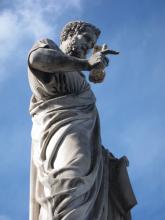
When Pope Francis canonizes Popes John XXIII and John Paul II on Sunday, Catholics across the spectrum will have reason to cheer: Liberals credit John with opening the church to the modern world in the 1960s, and conservatives hail John Paul as reasserting orthodoxy after too many innovations.
But the unprecedented double-barreled canonization also raises a question that might give both sides pause: Why is Rome making saints of almost every modern pontiff after nearly a millennium when almost no popes were canonized?
In the first 500 years of Christianity, the Apostle Peter (considered the first pope by tradition) and 47 of his 48 papal successors were viewed as saints, mainly because so many of them were martyred, which is the simplest route to canonization. Another 30 popes were named saints in the next 500 years, largely based on their reputation for sanctity.

Pope John Paul II won’t officially become a saint until a special high-profile ceremony next month at the Vatican. But the man who succeeded him says he has seen him in that light for years.
The Polish pontiff “did not ask for applause and never looked troubled when he was making difficult decisions,” Benedict said. “He acted in accord with his faith and beliefs, and he was willing to endure blows against him. I could and should not imitate him, but I did try to continue his legacy and his mission the best way I could.”
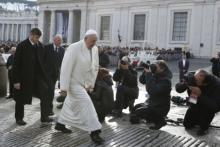
When cardinals gathered in the Sistine Chapel a year ago to choose a successor to Pope Benedict XVI, a frail 85-year-old who had become the first pope in six centuries to resign, many of them had one non-negotiable for the next pontiff: that he not be over 70 years old.
So what did the cardinals do? They elected 76-year-old Cardinal Jorge Bergoglio of Argentina — a man who had part of a lung removed in his 20s and who today “walks kind of crookedly,” as a former aide once put it, because he wears orthopedic shoes to help alleviate chronic lower back pain.
All in all, though, Pope Francis, now 77, seems to be doing quite well at the one-year mark of his papacy, despite maintaining a nonstop pace of liturgies, meetings, public appearances, and hours of prayer throughout a day that starts before 5 a.m.
“He eats works, it’s true,” said the Rev. Antonio Spadaro, a Jesuit priest — like Francis — who conducted a book-length interview with the pope last year and knows him well.
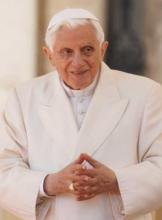
As the anniversary of his surprising resignation approaches, Pope Benedict XVI has rejected as “simply absurd” the speculation that he was forced to step down, and he said he still wears the distinctive white papal cassock for “purely practical reasons.”
“At the moment of my resignation there were no other clothes available,” Benedict wrote in a brief letter to an Italian journalist that was published on Wednesday.
The emeritus pope also said that he kept the name Benedict, rather than reverting to his birth name of Joseph Ratzinger, because it was a simple solution.
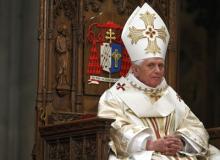
When Pope Benedict XVI officially left the Vatican in a helicopter a year ago this week, becoming the first pontiff in 600 years to resign, many in his conservative fan base were aghast, even angry.
He has betrayed us, said those who thought Benedict’s papacy would be the final triumph of old-school Catholicism. He has undermined the papacy itself, they worried. Lightning even struck the cupola of St. Peter’s Basilica hours after Benedict departed, surely a bad omen.
Rumors that he was suffering from a terminal illness were taken as gospel truth. After all, what else could explain Benedict’s unorthodox decision to abandon the Throne of St. Peter?

Pope Francis created his first batch of new cardinals on Saturday and used the ceremony to launch a new appeal for peace amid the violence racking so many countries.
Francis focused his remarks on the plight of Christians, but in an extemporaneous addition to his prepared text he also called on the church “to fight any discrimination” and “exclusion.”
“The church needs your compassion, especially at this time of pain and suffering for so many countries throughout the world,” Francis told the 18 new cardinals who were present in St. Peter’s Basilica, along with hundreds of other cardinals and bishops whose colorful vestments and diverse origins offered a grand tableau of global Catholicism.
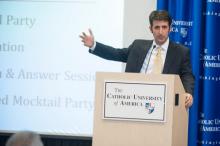
A group of leading Catholic activists and academics has renewed criticism of Catholic University of America over a large gift from the billionaire industrialist and conservative funder Charles Koch, and over a school official’s statements that seem to endorse Koch’s questioning of climate change and the right of public workers to unionize.
In a letter sent on Monday to CUA President John Garvey and Andrew Abela, dean of CUA’s new business school, more than 50 Catholic signatories said Charles Koch and his brother, David, “have a clear political and ideological agenda.”
The Kochs’ libertarian-leaning positions, they said, “are in direct conflict with traditional Catholic values.”
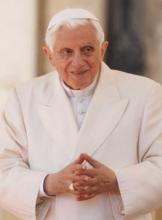
After a tumultuous year that saw the first papal resignation in nearly six centuries, the election of Pope Francis, and a dramatic reshaping of the church’s style and tone, the man who set those wheels in motion has no regrets.
Indeed, Pope Benedict XVI, now retired and living in seclusion inside the Vatican, is at peace in his new role and believes history will vindicate his difficult eight-year papacy, his closest aide said in a rare interview.
“It is clear that humanly speaking, many times, it is painful to see that what is written about someone does not correspond concretely to what was done,” Archbishop Georg Ganswein said in an interview with the Reuters news agency on the anniversary of Benedict’s surprise announcement on Feb. 11, 2013, that he would resign.
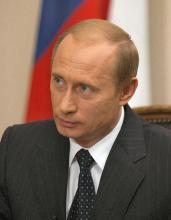
Next week’s summit between Pope Francis and Russian President Vladmir Putin may be the most important meeting between a pontiff and a visiting head of state in nearly a quarter of a century, with war-torn Syria expected to be the top priority.
Francis has met with more than a dozen heads of state or government as pontiff, and Putin has met with both Pope Benedict XVI and Pope John Paul II. But this meeting stands out.
It’s been just four years since full diplomatic ties were re-established between Russia and the Holy See, set against a backdrop of centuries of tension between the Vatican and the Russian Orthodox Church.
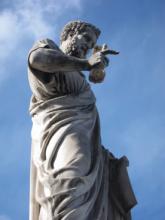
The Vatican said it would display for the first time bones believed to be the mortal remains of St. Peter, the leader of Jesus’ 12 apostles, to mark the end of the Year of Faith on Nov. 24.
Archbishop Rino Fisichella, president of the Pontifical Council for Promoting New Evangelization, wrote in Monday’s editions of L’Osservatore Romano, that the Catholic faithful making a pilgrimage to St. Peter’s tomb to mark the end of the Year of Faith will enjoy “the exposition … of the relics traditionally recognized as those of the apostle who gave his life for the Lord on this spot.”
Fisichella was referring to the long-held belief that Peter was crucified upside down and died in either A.D. 64 or 67 on the spot now marked by the Clementine Chapel inside the basilica that bears his name.
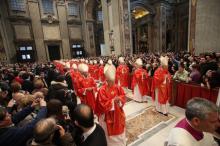
The National Security Agency spied on cardinals as they prepared to select the new pope — perhaps including even Cardinal Jorge Bergoglio, who emerged from last spring’s conclave as Pope Francis, a leading Italian news magazine reported in Wednesday’s editions.
Pope Francis still lives in the guesthouse, but the magazine did not speculate whether the phones there were still tapped.
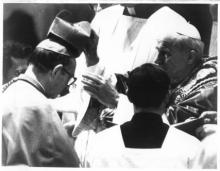
The election of Pope Francis in March heralded a season of surprises for the Catholic Church, but perhaps none so unexpected – and unsettling for conservatives – as the re-emergence of the late Chicago Cardinal Joseph Bernardin as a model for the American Catholic future.
While there is no indication that Francis knows the writings of Bernardin, who died in 1996, many say the pope’s remarks repeatedly evoke Bernardin’s signature teachings on the “consistent ethic of life” – the view that church doctrine champions the poor and vulnerable from womb to tomb – and on finding “common ground” to heal divisions in the church.
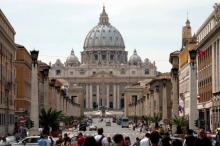
Pope Francis met for three hours with the heads of all Vatican departments on Tuesday, Sept. 10, signaling his desire to introduce more collaboration and transparency in the traditionally secretive and top-heavy governance style of the Catholic Church.
About 30 people attended, including the heads of the Vatican’s eight congregations and 12 councils, as well as top officials from the church’s tribunals and from the administration of Vatican state.
Cardinal Tarcisio Bertone, the Vatican’s outgoing secretary of state, also participated, in one of his last official engagements before his successor, Archbishop Pietro Parolin, takes over on Oct. 15.
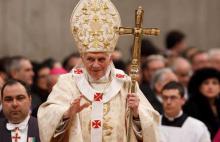
Pope Emeritus Benedict XVI resigned from the papacy because “God told me” to, according to a report by a Catholic news agency.
The Zenit news agency reported on Monday that Benedict decided to step back as a result of what he described as a “mystical experience” that shouldn’t be confused with a vision.
That experience sparked an “absolute desire” to dedicate his life exclusively to prayer, in a solitary relationship with God, Benedict reportedly said.
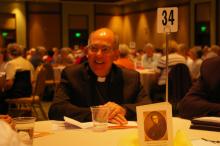
U.S. Catholic nuns — accused by Rome of “radical feminism” for advocating social justice at the expense of issues such as abortion, gay marriage, and euthanasia — responded to a Vatican knuckle rapping with a brief, conciliatory statement on Monday.
After its four-day annual assembly, the board of the Leadership Conference of Women Religious, which represents 80 percent of the nation’s 57,000 sisters, emphasized the positive, and remained tight-lipped about negotiations to resolve the investigation.
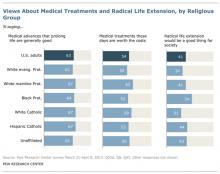
Noah’s grandfather Methuselah lived to the ripe old age of 969 and Moses reached 120, but most Americans would be happy to make it into their 90s, according to a new study.
Black Protestants and Hispanic Catholics are the most likely religious groups to say “radical life extension” — living to age 120 or more — would be good for society, according to a new Pew Research Center study, “Living to 120 and Beyond,” released Tuesday.
The speculative “Living to 120 and Beyond” survey comes against the backdrop of U.S. Census Bureau projections that suggest by 2050, one in five Americans will be 65 or older, and more than 400,000 will be 100 or older.
Pope Francis announced Monday in an airborne news conference that he’s ‘not one to judge’ the sexual orientation of Catholic priests. On his journey home from Brazil, Pope Francis declared open-mindedness by sharing his support on behalf of the gay community. The Washington Post reports:
“If someone is gay and he searches for the Lord and has good will, who am I to judge?” Francis asked.
Read more here.
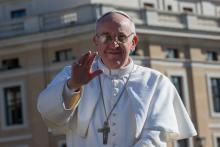
In his first official meeting with a Jewish delegation, Pope Francis on Monday reaffirmed the Catholic Church’s condemnation of anti-Semitism and vowed to further deepen Catholic-Jewish relations.
“Due to our common roots, a Christian cannot be anti-Semitic!” he told a delegation of the International Jewish Committee for Interreligious Consultations, the Vatican’s official partner for interfaith dialogue with the world’s Jews.
In his speech, Francis stated that the church condemns “hate, persecution, and all manifestations of antisemitism.”
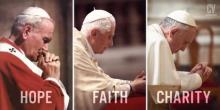
As a millennia-old institution, the Vatican is accustomed to change at a glacial pace. But in the eyes of many outside the church — and even of some within it — the arrival of Pope Francis on the throne of St. Peter seems to have started nothing short of a revolution.
Even Francis himself, in his speech to Rome’s diocese on Monday, said that Christians not only can, but should, be “revolutionaries.”
Now, 100 days into his pontificate, a debate is brewing in Rome over whether Francis has set a distinctly different course from his predecessor, or whether the visible differences in style and personality between Francis and Benedict XVI mask a deeper theological and ideological continuity.